Ask a Western European about Andorra, and most will note that it’s a great place to shop. This is because taxation on goods was previously non-existent and is still low enough that everything from designer clothing to sports equipment can be bought for 15 to 20 percent less inside Andorra’s borders than in the rest of Western Europe. The result of this is an inordinately high number of shopping-based tourists who visit the dense concentration of shops in the capital city, Andorra la Vella.
Ask a North American the same question, and they’ll scratch their heads and say, “Andorra is a place, right?” Fair, enough, almost. At just 180 square miles, the entire, ahem, place is the size of San Jose, California, but with less than 10% of its population–Andorra’s government said that there were 71,732 people living in Andorra in 2015. Andorra, too, is surrounded by the much more geographically imposing countries of France and Spain in southwest Europe. Even more, it’s gobbled up by the Pyrenees, a giant mountain range stretching roughly east-west across southwestern Europe and forming a natural topographic boundary between France and Spain–Andorra is just wedged in the middle of things there. Even more, it’s a non-European Union principality co-led by the President of France and the Catholic Bishop of Urgell in Spain but operated politically as a parliament-based democracy. This complicated modern story originates in the region’s even more complicated history as a medieval fiefdom located in topography-induced remoteness. This is all to say that Andorra probably gets left off many North American middle-school geography and high-school history lesson plans because of the high ratio of time needed to explain all this versus the miniscule relative land size of the principality compared to the rest of Western Europe.

Spain’s Sonia Regueiro Rodriguez during the 2016 Els 2900 Alpine Run in Andorra. Photo: Jordi Saragossa
Okay, okay, some foreigners are keyed into Andorra as an outdoor-recreation destination, but I think most of those people visit for alpine skiing. Today the principality has two ski areas, the larger Grandvalira and the smaller Vallnord. The areas draw upon mostly Western European outdoor enthusiasts as their alpine-skiing tourists.
But the people of Andorra itself–as well as the people who live immediately around Andorra in Catalonia and France–really know their mountains and their mountain sports. In 2009, the Gerard Martínez and Valérie Lafleur founded the Andorra Ultra Trail Vallnord, now Andorra’s largest trail running event. Explains Gerard about Andorrans’ relationship with the mountains, “Andorrans practice a lot of hiking because we are fortunate to have a wide network of paths that have been used for centuries to communicate between the different valleys of the country. During the winter, many of us practice ski mountaineering or cross-country skiing. Indeed, mountains are our pitch during the whole year.” Matt Lefort, co-race director of the Els 2900 Alpine Run and other mountaineering events in Andorra, similarly explains, “All my friends here at least do mountain running, ski mountaineering, and/or ski touring as well as road cycling. Of course you have some athletes focusing on one or the other sport but generally speaking, cross training is a common thing!”
My personal curiosity about Andorra’s trail running has been quietly growing in the last half decade, as news snippets and images from the Andorra Ultra Trail Vallnord and, more recently, the Els 2900 Alpine Run, have crept across the ‘pond’ and onto my viewscape. Over these same years, I encountered a couple people who’d participated in one of Andorra’s events and who spoke highly about the area as a trail running destination. Finally, my curiosity was piqued enough that, in 2016, I visited Andorra not once but twice–once in the spring and a second time in fall. I have since joked with my friends that my trips to Andorra were sponsored by Google Translate. I used it for everything, from the research process before going there, to translating signs and menus while in the country. Since I had a hard time finding information about Andorra trail running and other tourism in English, I’ve tried to conglomerate the major aspects of what I’ve learned and the perspectives of a couple leaders in the Andorran trail running community in this article with the hope that it becomes the skeleton by which other English speakers plan their adventures there.
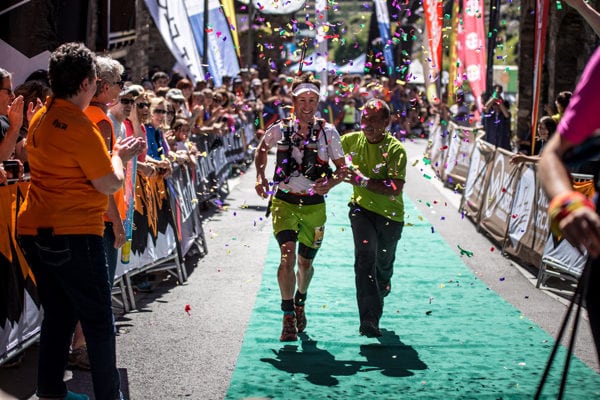
Andorra’s Xavi Teixido wins the Ultra Mític 112k at the Andorra Ultra Trail Vallnord. Photo: Andorra Ultra Trail Vallnord
Trail Running Scene
Prior to my first visit to the Andorran Pyrenees, I had strong familiarity with another Western European mountain range, the Alps, and a just bit of understanding of the Pyrenees within Spain. In these places, I had come to understand that mountain culture as just, well, ‘culture.’ That is, the mountains are inherent to the lives of the humans who reside in and near them, and it’s been this way for generations upon generations. No matter the season or the steepness of terrain, people go on with all the trappings of ‘regular life’ in the mountains.
The Andorran Pyrenees, I found, are the same: human life and the mountains are inextricably intertwined and have been for all of Andorra’s history. Once you get a couple kilometers outside of the capital city of Andorra la Vella, and with the exception of the super tourist-y ski-resort bases, Andorra switches immediately to rural and based upon intimate interactions with the natural world.

A seasonal homestead and livestock grazing grounds in the Madriu-Perafita-Claror Valley of Andorra. Photo: iRunFar/Meghan Hicks
For example, Andorra’s extensive trail network was originally designed largely as means of connecting villages and livestock rangelands. While Andorra’s equally extensive road network has generally eliminated the use of trails as connectors of civilization, the trails are still used to move livestock and almost every trail adventure today will include an ‘interaction’ with horses or cows. And, of course, the use of these trails and the building of more for recreation–for hiking, to access off-trail skiing and mountaineering terrain, and for trail running, among other forms of recreation–has proliferated. Almost every trail junction has directional signs indicating hiking times to other places. And dozens of refuges, huts, and cabanas are located along the trail system, and they provide opportunities for getting inside and out of the elements. For someone who has experienced mountain ranges all over the world now, all of this together contributes to an overall ‘civilized’ feel to the trails of Andorra. When you are on a trail, you’re never more than a couple kilometers from a village, road, or some sort of shelter.

Scenery during the 2016 Pirinenc Clàssic in Andorra. Photo: David Ariño
That said, the terrain of the Andorran Pyrenees can probably be best described as ‘rough.’ Vertical offset is a given–tagging a peak, for instance, might mean 4 kilometers of ‘horizontal’ travel with 1,000 meters of climbing one way. Much of the rock is shale-y, and it crumbles underfoot and underhand. Forests dominate the terrain until about 2,000 meters altitude and then above that are small alpine plants and just rock exposure. Andorra’s tallest mountain is Comapedrosa at 2,943 meters altitude, so it’s relatively low altitude compared to other mountain ranges around the world.
Matt Lefort summarizes the feel of the Andorran Pyrenees, “The mountains are overall pretty wild. What I love about the ones in Andorra is that you have 100 peaks at your doorstep within a radius of 20 kilometers!”
Gerard Martínez explains the phenomenon of trail running in Andorra as he sees it, “Andorra has a very old tradition of trail running. For many years, there have been a lot of people organizing mountain races. Since the establishment in 2009 of the Andorra Ultra Trail Vallnord, the practice of trail has grown a lot, especially long races. Among Andorra’s small population, 850 have participated in our events. This ratio is probably one of the highest in the world.”
So, trail running and racing are on the increase in Andorra, but so now is alpine racing and mountaineering racing, which means in part getting off Andorra’s actual trails and onto more technical off-trail terrain. This next evolution in style is coming courtesy of Matt Lefort and co-race director Carles Rossell, who together invented the Els 2900 Alpine Run in 2015, as a mixed-terrain course connecting Andorra’s highest peaks. Here’s what Matt says about Els 2900, “The original code for the Els 2900 project was Baby Nolan’s! True story. Since the logistics to set up a Nolan’s 14 attempt was a bit challenging from Europe, we dreamed about doing something similar here in the Pyrenees. A fast route with a meaning—connecting the seven highest peaks of the country, all above 2,900 meters—wild and technical, including as many ridges and couloirs as possible. And from hut to hut. To make it even more remote!”
In 2016, Matt and Carles took another step forward and started mountaineering-style races called the Pirinenc Clàssic. About the Clàssic series, Matt explains, “We’re now headed to more technical ridgelines and we are definitely getting out of the running world. The aim is to move fast and light in the mountains, carefully choosing the right gear to cover extended, exposed ridgelines. Hence we will have a race next June that will cover 23 peaks in less than 22 kilometers! No course marking, just a ridgeline to follow in order to tag as many peaks as possible within 15 hours.” This latest iteration, fast mountaineering–not running–but in a race format, to my knowledge, doesn’t have many other modern comparables. Maybe something like the Elbrus Race in Russia can compare?
Gerard Martínez, Valérie Lafleur, Matt Lefort, and Carles Rossell all seem to be traveling different means to achieve similar ends: developing and supporting the Andorran outdoor community and inspiring love of place in its members.
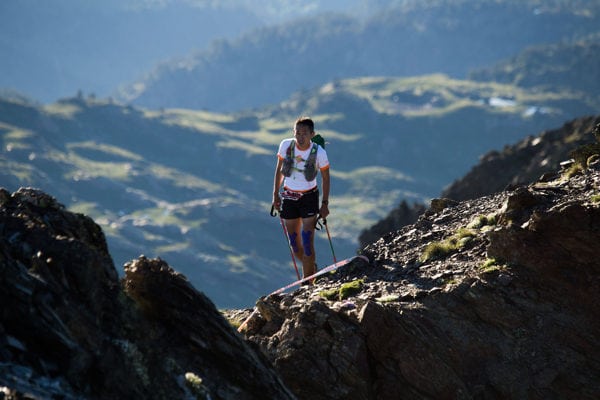
A competitor during the Andorra Ultra Trail Vallnord. Photo: Andorra Ultra Trail Vallnord
Trail Run Itineraries
The trail network of Andorra is excruciatingly robust. It’s beautifully nuts in how many places there are to run. Here are a couple starter itineraries.
Comapedrosa Out-and-Back
Do an out-and-back run to Andorra’s high point Comapedrosa, which is 2,943 meters tall. Above the village of Arinsal is an unusual avalanche-c0ntainment structure. Drive through it and then take an immediate right, where you will see a small trailhead parking area at the base of Torrent Ribal. From here, it’s about 13 kilometers/8 miles roundtrip and 1,360 meters/4,450 meters of climb to the top and back. Eight miles roundtrip doesn’t sound like far, but this outing runs like a medium-distance run because of the elevation gain and technical final ridge. The trail starts as wide doubletrack and quickly narrows to singletrack.
You’ll encounter a number of trail intersections, but all are marked. You’re following the GR-11 almost all the way, until you deviate from it at l’Estany Negre, a small lake, to go up the southwest ridgeline of Comapedrosa to its summit. This final bit is the only tricky part, with scree and then a nubby, rocky ridgeline. There’s no dangerous exposure per se, but the ridge has an airy feel. Yellow dots mark the route from the GR-11 to the summit.
Return from whence you came. Time things well and you can stop into the Refugi Comapedrosa, which is about 45 minutes at a good jog downhill from the summit, for some food and drink. There are plenty of water sources along the way, too, but filter/treat anything you use. Check out this route on Wikiloc.
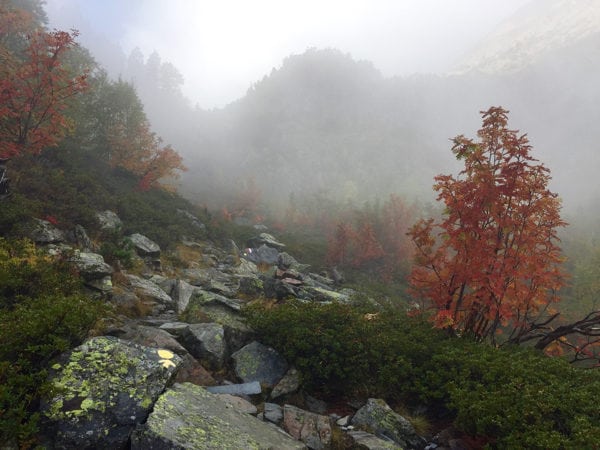
A foggy morning on the GR-11 en route to Comapedrosa. Photo: iRunFar/Meghan Hicks
Pic de l’Estanyo Lollipop
Park at the Sorteny Natural Park parking lot above the village of El Serrat. From here it’s a doubletrack up to a bit before Refugi Sorteny, though there’s some singletrack between the doubletrack road that shortens and steepens this section if you wish. Make a right turn at the sign pointing to Estany de l’Estanyó, the lake which sits beneath the peak. You’ll cross the river valley and climb steeply up to the lake. From there, the route gains the west ridge of the peak all the way to the summit.
At the summit, head off on the trail to the southwest along an outstanding ridgeline until you get to Collada de Ferreroles, a little pass. From there, you’ll drop steeply back into the valley containing Estany de l’Estanyó and complete the loop. Follow the trail from where you came, and consider a short deviation to the Refugi Sorteny if they are open for some treats! Check out this route on Wikiloc.
All in all, this route rings in at about 14.5 kilometers/9 miles with 1,200 meters/3,900 feet of climb. The ridge running to the southwest of the summit is really something else. Pic de l’Estanyó is one of Andorra’s tallest mountains, topping out at 2,915 meters. Creeks and the lake make water sources readily available, but treat whatever water you use–remember it’s livestock rangeland pretty much everywhere in Andorra!

Estany de l’Estanyó as seen from the west ridge on the approach to Pic de l’Estanyó. Collada de Ferreroles is in the left of the photo. Photo: iRunFar/Meghan Hicks
Trail and Mountain Races
Trail and mountain racing in Andorra is growing quickly right now. Here are some of the events.
Andorra Ultra Trail Vallnord
This is Andorra’s largest trail running event, and in 2017 it will contain six races ranging from 10k to 233k in length and it’s held annually in July since 2009. The Andorra Ultra Trail is probably most famous for its Ronda dels Cims at 170k in length. In 2016, there were about 2,600 starters among all of its events.

The village of Ordino serves as the start and finish lines of the Andorra Ultra Trail Vallnord events. Photo: Andorra Ultra Trail Vallnord
For 2017, the event will host for the first time a two-member team, non-stop event called the Eufòria dels Cims, which will be 233k in length. The village of Ordino serves as the start and finish lines, and the event’s host.

During the Andorra Ultra Trail Vallnord. Photo: Andorra Ultra Trail Vallnord
Els 2900 Alpine Run
This is a 70k alpine run over Andorra’s seven highest peaks. Along with some on-trail travel, the route includes Class 4 and lowest 5 (Yosemite Decimal System) scrambling with some opportunities for clipping into fixed safety lines set by the race’s safety crew, a via ferrata, and other off-trail travel via a closed, marked route that’s closely observed by volunteers and safety crew.
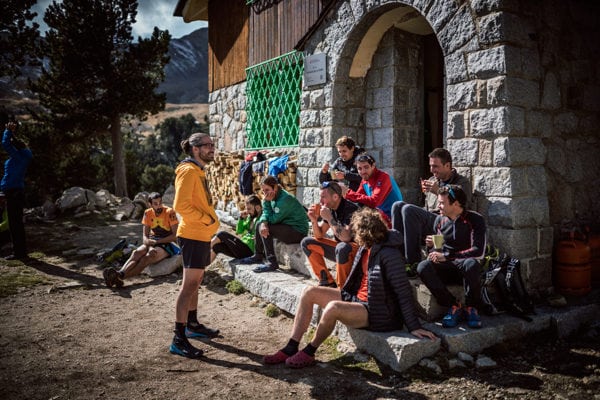
Competitors and co-race director Matt Lefort (yellow sweatshirt) at the Refugi Estanys de la Pera, the Els 2900 starting line, ahead of the 2016 race start. Photo: Jordi Saragossa
A maximum of 50 total participants are allowed, and you have to apply with the appropriate skills for acceptance into the race. Notably, the race starts and finishes in mountain refuges, requiring a hike in and hike out from the start and finish lines and facilitating a close-knit community atmosphere among participants and race organizers.
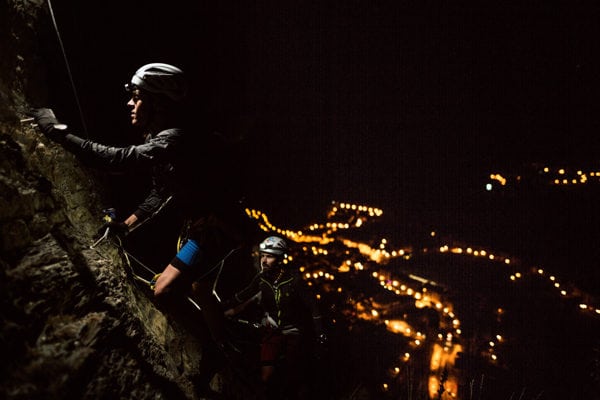
A competitor on the via ferrata during the 2016 Els 2900 Alpine Run. Photo: Jordi Saragossa
Pirinenc Clàssic
These are new-in-2016 mountaineering races in the Andorran Pyrenees, fast-and-light travel in teams of two over various kinds of mixed-mountain terrain. These events have been developed by the organizers of the Els 2900 as an even-more-technical take on fast mountain travel. I haven’t seen the courses first-hand, but from what I understand, expect these events to have a much stronger mountaineering feel than the Els 2900.
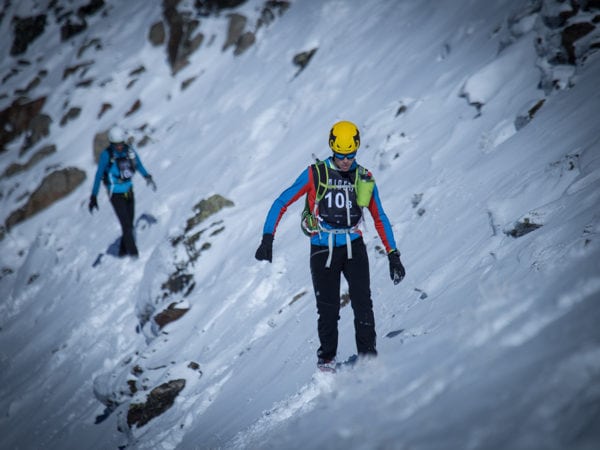
A team during one of the 2016 Pirinenc Clàssic events. Photo: David Ariño
Again, a max of 50 total participants are allowed and you have to apply with the appropriate skills for acceptance into the events. Like Els 2900, the races start ‘on the mountain,’ meaning that there’s a commute to and from the start and finish lines.
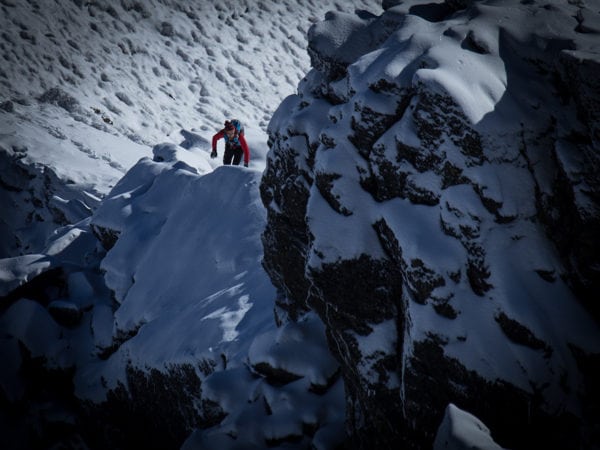
Co-race director Matt Lefort competes in his own 2016 Pirinenc Clàssic. Photo: David Ariño
Skyrace Comapedrosa and Skyrace Arinsal
These are 21k and 15k races that took place in July of 2016 and will occur again in 2017, starting and finishing in the village of Arinsal. The longer race traverses Andorra’s high point, Comapedrosa. These races were part of the Skyrunner World Series and the Spain-Andorra-Portugal Skyrunner National Series in 2016, and it looks like it’s the same for 2017. It appears that the race started in 2014, and there are a couple hundred entrants across the two races.
Where To Stay
With tourism as Andorra’s main economy, there are lodging facilities literally everywhere. By far the greatest concentration of lodging is in Andorra la Vella, the capital city, and around the principality’s ski areas. Lodging opportunities range from large, luxury hotels, to smaller hotels, to aparthotels where all the lodgings come with kitchen facilities, to diverse private lodging opportunities. There are also a few camping areas, where you can bring a tent or RV camper, but these are only open in the height of Andorra’s summer season.
If you are visiting Andorra for trail running, I recommend you lodge yourself outside of the capital and close to the trails. I stayed several nights in the small town of Ordino, twice at the Hotel La Planada, which is a small family-owned operation. You can add a breakfast buffet and three-course dinner (sometimes a buffet and sometimes ordered individually) onto your room at totally reasonable rates. I also stayed a couple nights at the Aparthotel Casa Vella, located across the street from Hotel La Planada. A kitchen is included in all rooms and there are rooms with jetted tubs–which I admit was pretty awesome after a big day in the mountains. You can add on a breakfast buffet to the cost of the room. Both can be booked on various online booking websites, and both offer free parking. You can run to several trails within five or 10 minutes. Ordino is a cool little town, a hub of various mountain sports.
I also rented a private apartment attached to an Andorran family’s mountain home via AirBnB in the mountain village of El Serrat, and this was by far my favorite way to lodge in Andorra. The house was located at 1,600 meters altitude, and singletrack went every direction from the house. The family was warm and welcoming, and they provided fantastic information about exploring in the mountains. I sincerely recommend seeking a personalized, local experience like this, if you can.
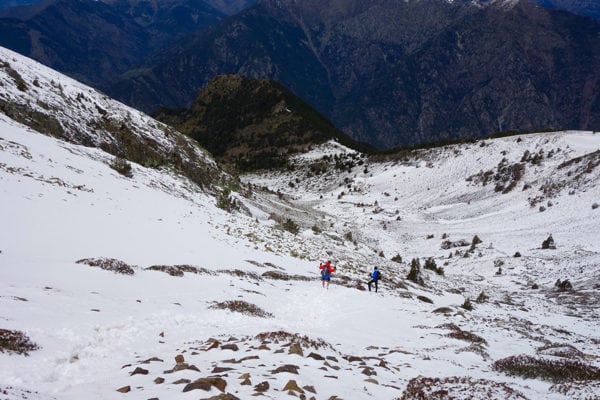
Spring conditions at middle elevations the Andorran Pyrenees. Photo: iRunFar/Meghan Hicks
Other Things To Do During Trail Running Season
Caldea
It’ll be hard to miss Caldea, an 18-story building made to look something like an abstract ice palace and operating as one of Europe’s largest spas, if you arrive via Andorra’s capital city. Your ticket gives you entrance to a large series of pools with jet and waterfall features located both inside and outside, several steam rooms, and hot tubs. The inside is designed in mostly white marble features and has a Greek feel. I visited on a weekday afternoon and the facility was kind of crowded with high-school-aged kids on what seemed like a field trip, but the place was big enough that I was able to relax despite the other high-energy visitors.
Dining in a Borde
Bordes are structures located all over the Pyrenees that have historically been used in pastoralism. They are generally two stories, and livestock was kept overnight in the bottom, basement-esque level while the livestock’s food and herders dwelled in the level above. Some of these bordes are still being used in their intended way, some have gone into disrepair, some have been converted to homes, and more than a dozen have been made into restaurants in Andorra. Andorra has a robust dining culture, and when people go out to restaurants, they generally go for long, multi-course meals with large groups. Call it an experience, not just a meal. Andorran cooking is heavy on the meats and cooked vegetables, and flavors generally stay in the range of savory. I highly recommend experiencing Andorra’s food culture via one of its borde restaurants. Even if you end up going to one by yourself and even if you can’t speak Catalan, I found that the surrounding tables and servers chatted me up and helped make the experience rewarding.
Road Biking
Traveling with a road bike or interested in renting one at one of the many shops in Andorra? Road biking and touring is super popular on Andorra’s always curving, climbing, or descending roads. Most of the roads, save for the biggest and busiest, are marked with signs for bikers indicating what’s ahead. None of the roads have shoulders, so bikers integrate into traffic.
The Rossell Forge Interpretive Centre
In the 1800s, iron ore was one of the few natural resources plied from the surrounding Pyrenees, worked at the Rossell Forge, and then sold in the markets of the principality and beyond, especially in Spain. The interpretive center offers multi-lingual slide shows, tours, and demonstrations to help tell this story.
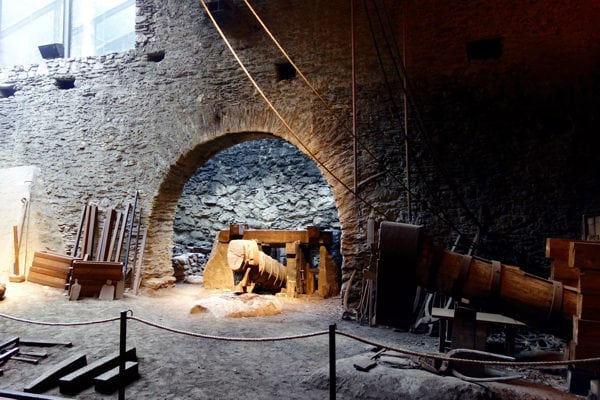
The Rossell Forge Interpretive Centre. Photo: iRunFar/Meghan Hicks
Tour Andorra’s history
Visit one of Andorra Turisme’s visitor offices and pick up a slew of free goodies like maps, tourism routes, and hiking guides. I got the guides in English, but saw they were available in Catalan, Spanish, and French, too. These describe religious structures, museums, outdoor interpretive paths, and more that allow you to learn about and experience Andorra’s rich history. I was impressed with the amount of free literature and free access to Andorra’s history in my native language. There’s a lifetime of cultural learning you can do in Andorra. Also, the VisitAndorra website has loads of info for your pre-arrival research, and in multiple languages.
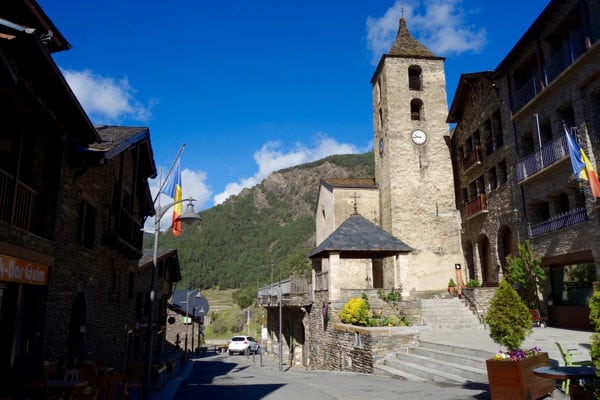
The Església de Sant Corneli i Sant Cebrià in Ordino. Photo: iRunFar/Meghan Hicks
Overnight in a Mountain Refuge, Hut, or Cabana
There are dozens of staffed and unstaffed buildings dotting the trails of Andorra, and they allow you to stay up high in the mountains. The buildings called refuges are the largest and generally staffed (some have off-seasons and many are very popular, though, so check with a tourist office ahead of time on how to book one you want to visit), and you can rent a bunk and/or buy a meal or several.
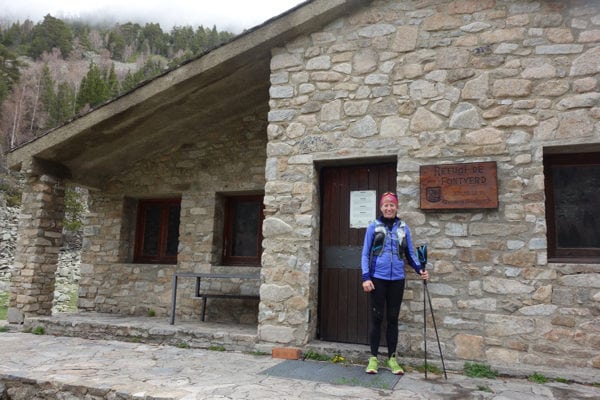
The author at the unstaffed Refugi Fontverd. Photo courtesy of iRunFar/Meghan Hicks.
There are also other unstaffed refuges, huts, and cabanas up there, which offer indoor space, a place to make a fire and heat the structure, and sitting and sleeping areas. They are all situated with some sort of water nearby, though it should be treated before drinking. These unstaffed structures are first-come-first-serve, and you’ll often be alone in them. But if others come along, be prepared to share the space! Also, there’s no trash disposal and often no outhouse, so practice Leave No Trace.
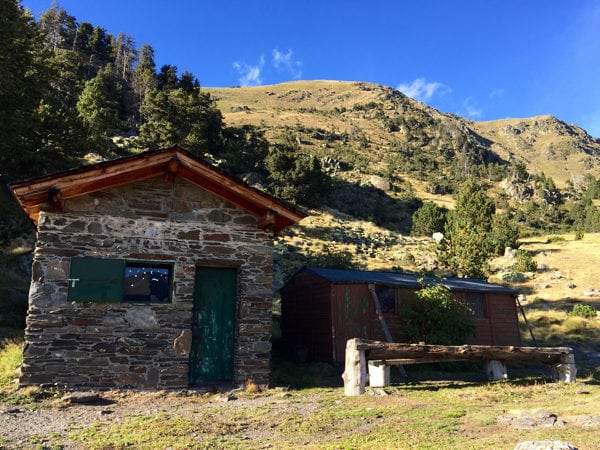
An unstaffed cabana in northern Andorra. Photo: iRunFar/Meghan Hicks
Via Ferratas
There are more than a dozen via ferratas in Andorra, but several are concentrated on the rock face above the town of Canillo. The via ferratas are free to use, maintained by the Andorran government, and open to the public during daylight hours. Numerous stores offer rental or sale of the kit needed for the via ferratas, and you can also hire a guide to take you if you haven’t been on a via ferrata before.
How To Get Around
- Multiple bus services are offered several times a day from Barecelona, Spain and Toulouse, France. I used Andorra by Bus and was able to book drop-offs/pick-ups to my hotel.
- Public busses go everywhere there are roads, basically, in Andorra. Chances are, wherever you are, or wherever you’re staying, or wherever you want to go, there’s a bus stop within a few hundred meters. The closer you are to the capital city and the closer it is to Andorra’s ‘on’ seasons–the hearts of summer and winter–the more frequent the bus schedule is. Depending on your origin and destination, you may have to transfer buses. I recommend stopping by one of Andorra’s tourism offices and asking them to explain how to travel by bus to and from wherever you are staying.
- Renting a car for your stay from the Toulouse or Barcelona airports makes for your most flexible option for accessing trailheads. If you have a car, parking requires payment in all but Andorra’s littlest villages. Generally, there’s a nearby machine into which you feed a few coins and get a ticket in return to display. Andorra’s larger towns have parking garages, and many offer 30 minutes or an hour of free parking before you have to pay. Parking fees are definitely enforced in any of these circumstances.

A competitor during the 2016 Els 2900 Alpine Run. Photo: Jordi Saragossa
More Resources and Things to Know
- Typical to Western Europe, most businesses shut their services in the mid-afternoon, in the range of 2 to 4 or 2:30 to 4:30 p.m. This often includes tourist businesses, like museums and churches, and grocery stores. But, all the restaurants are open for an extended lunch!
- Catalan is the official language of Andorra, but many people speak some or even a lot of French and Castilian Spanish. English is not well spoken.
- The weather of the Pyrenees can be brutal, and changes quickly. Pack a winter-running kit even if you’re planning a summer visit to Andorra. Fog and clouds can quickly obscure alpine routes, even on days with a good weather forecast. Carry a map and compass as well as a smartphone with a GPS-enabled app that allows you to track your movements on an electronic topographic and trail map.
- Wikiloc is used by Andorran outdoor enthusiasts for uploading GPS tracks of routes, and the company has a great GPS-enabled smartphone app that’s useful on the mountain.
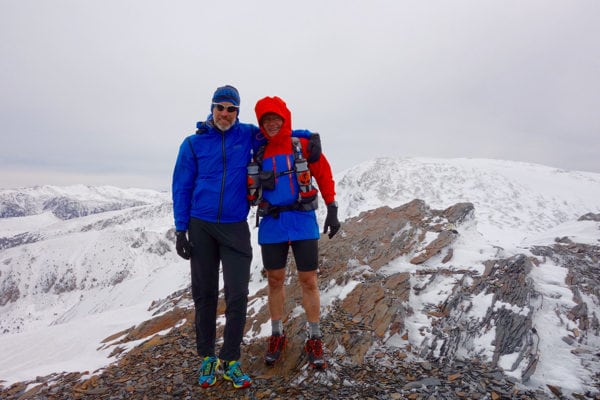
On top of Pic Negre in windy and cold weather with Andorra Ultra Trail Vallnord race director Gerard Martínez (right) and Francesc Poujarniscle. Photo: iRunFar/Meghan Hicks
Call for Comments
- Andorran trail runners, can you comment with some other trail running itineraries? Some good half-day and full-day outings?
- Have you participated in an Andorran trail race? If so, which one and what was it like for you?
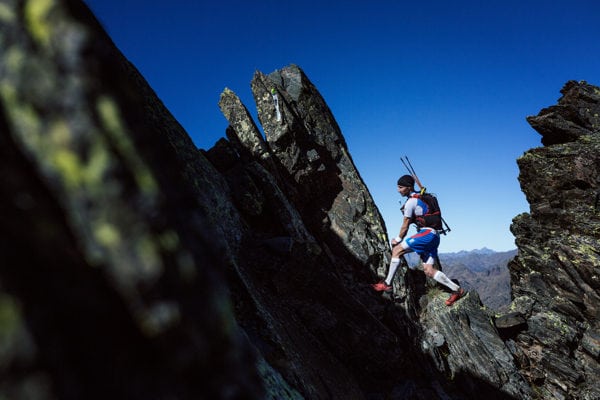
Andorra’s Xavi Teixido on his way to winning the 2016 Els 2900 Alpine Run. Photo: Jordi Saragossa

